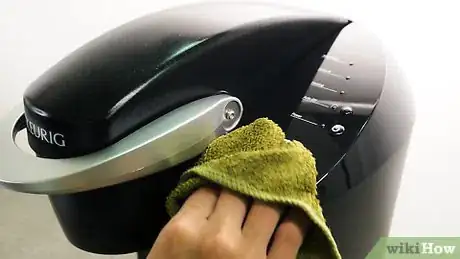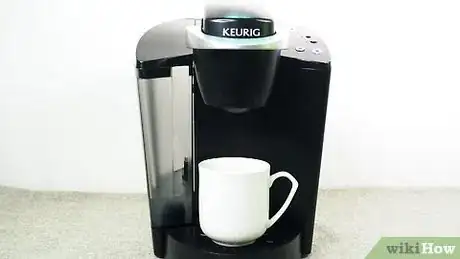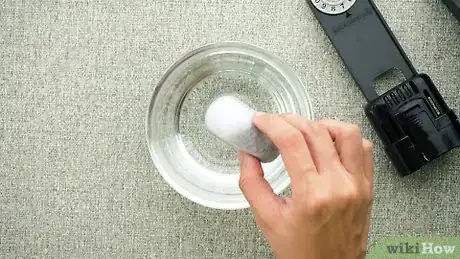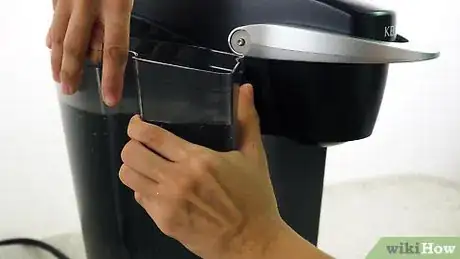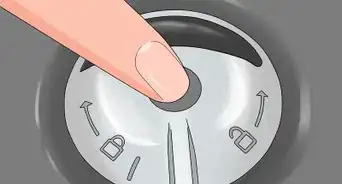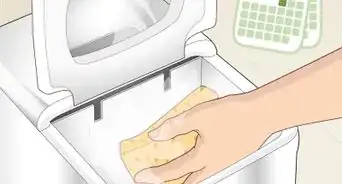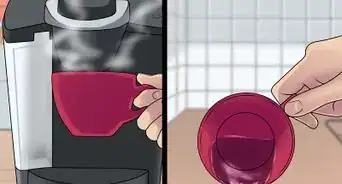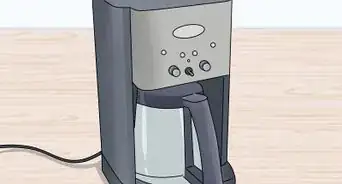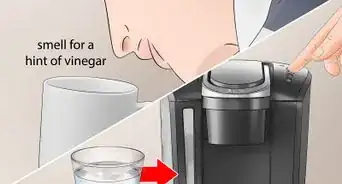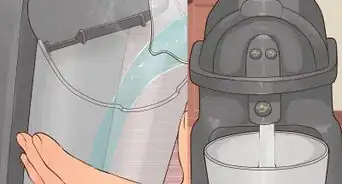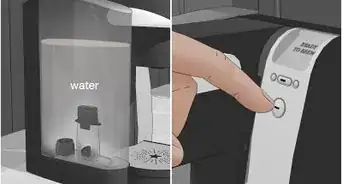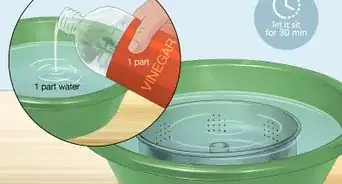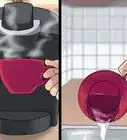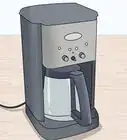This article was co-authored by James Sears and by wikiHow staff writer, Hunter Rising. James Sears leads the customer happiness team at Neatly, a group of cleaning gurus based in Los Angeles and Orange County, California. James and the team have nine years of experience and offer green cleaning, interior and exterior window washing, and general apartment cleaning services. He provides transformative cleaning experiences by reducing clutter and renewing your home environment. James is a Trustee Scholar at the University of Southern California.
There are 19 references cited in this article, which can be found at the bottom of the page.
wikiHow marks an article as reader-approved once it receives enough positive feedback. This article received 29 testimonials and 86% of readers who voted found it helpful, earning it our reader-approved status.
This article has been viewed 2,912,147 times.
Keurigs are great for making single cups of coffee, but over time, they can get dirty and buildup can form inside the machine. Every now and then, you need to clean your Keurig so it keeps making full cups of flavorful coffee. Every week you should clean the removable parts, and you should change the filter and descale the machine every few months. When your Keurig is clogged, you can manually clean out the pod holder and needle. Once the machine is clean, your coffee will taste fresh with each brew!
Steps
Performing Weekly Maintenance
-
1Wipe the entire machine with soapy water. Mix liquid dish soap in a sink full of warm water. Wet a cleaning cloth in the soapy water and wring it out so it’s not dripping. Wipe all of the exterior surfaces on your Keurig to clean off any dust or dried-on coffee. Focus on areas like the mug tray and pod holder since they get the dirtiest.[1]
- Make sure there isn’t a K-cup or coffee pod in the holder when you start cleaning.
- If your Keurig has a touchscreen display, wipe it dry with a paper towel when you’re finished cleaning it so it doesn’t get damaged.
EXPERT TIPJames Sears leads the customer happiness team at Neatly, a group of cleaning gurus based in Los Angeles and Orange County, California. James and the team have nine years of experience and offer green cleaning, interior and exterior window washing, and general apartment cleaning services. He provides transformative cleaning experiences by reducing clutter and renewing your home environment. James is a Trustee Scholar at the University of Southern California.House Cleaning Professional
 James Sears
James Sears
House Cleaning ProfessionalOpt for an all-natural, plant-based cleaner to clean your Keurig. Whenever possible, try to avoid using toxic or synthetic chemicals around an item that you'll be eating or drinking from.
-
2Remove and wash the bottom reservoir. The bottom reservoir is underneath the mug tray and is used to catch any accidental spills. Pull out the bottom reservoir and soak it in your sink filled with soapy water. Scrub any stuck-on residue with your cleaning cloth before rinsing it off.[2]
- The mug tray usually rests on top of the bottom reservoir. You can either wipe the mug tray with a cloth or soak it in your sink.
Advertisement -
3Soak the water tank in soapy water. Pull the tank off of the Keurig and empty the water into your sink. Rinse out the tank with warm water before soaking it. Scrub the inside of the tank with your cleaning cloth before rinsing it clean again.[3]
- If you have a Keurig filter in the water tank, pull it out before washing out the tank.
Warning: Don’t use a towel to dry off your tank since you could get lint inside of it.
-
4Let the bottom reservoir and tank air dry. Put the tank and reservoir upside down on a drying rack so they can air dry. Leave them to dry completely before putting them back on your Keurig. Don’t use a towel to dry them since it could leave lint inside the tank.[4]
Unclogging the Needle and Pod Holder
-
1Pull out the pod holder from the top. Lift the handle on top of your Keurig to access the pod holder. Grab the edges of the pod holder and pull up carefully to remove it from the machine. The pod holder cartridge will easily come out so you can clean it.[5]
- Be careful of the needle above the pod holder since it’s sharp.
-
2Separate the funnel from the pod holder. The pod holder is made with 2 pieces that are held together in the middle. Gently pull the pod holder apart to remove the bottom funnel from the pod compartment. You may need to twist the funnel to help loosen it.[6]
- Take apart the pod holder over your sink or a paper towel in case leftover coffee grounds fall out
-
3Poke a paper clip through the tube on the pod holder. Unbend a paper by hand until it’s straight. Stick the end of the unbent paper clip into the small tube at the bottom the Keurig’s pod holder to break apart any clogs. Take the paper clip out of the pod holder so any residue you broke apart can fall out through the hole. Keep poking into the pod holder until you don’t see anymore residue.[7]
- You can also use a toothpick if you don’t have a paper clip.
-
4Rinse the pod holder and funnel under warm water. Turn on your sink so it’s running warm water. Hold the pod holder and funnel upside down underneath the water to rinse any residue out. Rotate the pod holder and funnel under the water until it’s completely rinsed.[8]
- Avoid using any soap while cleaning out your pod holder since it could affect the flavor of your coffee if it’s not completely rinsed out.
-
5Clean the inside of the needle with your paper clip. The needle is located inside your Keurig above the pod holder. Use the same paper clip you used to clean the tube on the pod holder and poke it inside the hole in the center of the needle. Work the paper clip back and forth to loosen any coffee grounds or scale that may have gotten stuck inside.[9]
- Be careful while cleaning the needle since it is sharp and could hurt you.
Tip: Some Keurig needles will have 2 holes in them. Be sure to clean out each hole so water can flow easily through it.
-
6Put the pod holder back in your machine. Reattach the funnel and the pod compartment by pressing them together. Set the entire pod holder into the space where you pulled it out and gently push it back into place. The pod holder will click once it’s secured again.[10]
- There is usually an arrow on the pod holder and the Keurig to show which way to insert it. Make sure the pod holder is lined up correctly.
-
7Run 2 water-only cycles through your machine. Place an empty mug on the mug tray underneath the dispenser. Fill the water tank up to the max fill line and start a water-only cycle on your machine. Let the water fill the mug until the first cycle is finished. Empty the mug and run the machine one more time without a K-cup so it can clean out any residue.[11]
- Some Keurig machines will make you press a button on a touchscreen to confirm that you want to run the cycle without a K-cup. Other machines may make you lift the handle and close it again before starting another cycle.
Descaling the Tank
-
1Empty the water tank and remove the filter. Take the reservoir off of your Keurig machine and dump out any water that’s inside it. If your Keurig has a water filter, pull it out of the tank and set it aside while you descale the machine. Put the water tank back onto your Keurig once it’s empty.[12]
-
2Mix equal parts descaling solution and water in the tank. Pour a full bottle of Keurig descaling solution into the water tank, which is usually around 14 fl oz (410 ml). Fill the bottle again with water from your sink and add it to your tank to dilute the solution.[13]
- You can buy Keurig descaling solution online or in the kitchen section of big box stores.
Tip: You can also use white vinegar to clean descale your Keurig. Instead of mixing it with water, fill the tank with vinegar up to the maximum fill line.
-
3Run the Keurig until the “Add Water” light blinks. Place a mug underneath the dispenser so the solution doesn’t spill when you run it. Make sure there isn’t a K-cup inside the machine before you start running a regular brew cycle. Start the machine and let the first cycle fill the mug. Once the first cycle is over, empty the mug and start another cycle immediately. Keep running cycles until the tank is empty and the “Add Water” light starts blinking.[14]
- If your Keurig has a touchscreen, the screen will display when it needs more water in order to run.
-
4Let your Keurig sit for at least 30 minutes. Your Keurig stores some of the solution inside an internal reservoir after you run the cycles. Leave your Keurig alone for at least 30 minutes so the descaler can break apart any residue or buildup inside the reservoir.[15]
- If you’re using vinegar to descale your Keurig, leave it alone for about 4 hours so it has time to break down the buildup inside.
-
5Fill the tank with clean water. Pour out any leftover solution or liquid into your sink and rinse it underneath warm water. Make sure you rinse the tank thoroughly so there’s no solution left inside. Fill the tank to the max fill line with clean water and put it back on your machine.[16]
-
6Run through water-only cycles on your Keurig at least 12 times. Set a mug on the mug tray and run a hot water-only cycle through your machine. Once the first cycle is complete, empty the mug and run another cycle immediately after. Keep running cycles until you’ve done it 12 times to clean out all of the descaler solution.[17]
- You may have to fill the water tank at least once to run all of the cycles.
- Descale your Keurig every 6 months.
Replacing the Water Filter
-
1Soak a new filter in water for 5 minutes. Keurig filters should be replaced every 3 months or every 60 times you fill the tank. Take the replacement filter and put it in a bowl of cold water. Let the filter soak for at least 5 minutes before putting it in your Keurig. This helps the filter work better once it’s inside your tank.[18]
- You can buy new Keurig filters online or in the kitchen section of big box stores.
-
2Pull out the filter tube from your water tank. The filter tube is usually found in the middle or near the back of your Keurig’s water tank. Simply pull the tube out from the Keurig and set it on a piece of paper towel so it doesn’t get your counter wet.[19]
- Not every Keurig will have a filter.
-
3Take apart the bottom of the tube to remove the old filter. Keurig filters consist of a long tube and a mesh piece on the bottom to hold the filter in place. Grab the mesh piece on the bottom and pull it loose to take out the filter. Once you remove the old filter, throw it away.[20]
- Take out the old filter while the new one is soaking. That way, once the new filter is done soaking, you can immediately put it in.
-
4Rinse the new filter in water for 1 minute. Take the new filter out from the bowl of water and rinse it underneath cool water. Rotate the filter in your hands to rinse it completely. Keep the filter underneath the stream of water for at least 1 minute before you put it in the tube.[21]
-
5Place the new filter in the tube and put it back in the tank. Hold the filter tube upside down and set your filter inside of it. Replace the mesh bottom to secure the filter in place before putting the filter back into your Keurig. Once the filter is replaced, you can immediately use the Keurig again.[22]
Community Q&A
-
QuestionWhy is the machine giving me a small cup when I push large?
 Community AnswerIf you use hard water to brew, the vinegar rinse described above may break down water scale clogging the machine. Otherwise, your exit needle is probably clogged. Prime the keurig to clear it out.
Community AnswerIf you use hard water to brew, the vinegar rinse described above may break down water scale clogging the machine. Otherwise, your exit needle is probably clogged. Prime the keurig to clear it out. -
QuestionKeurig says you cannot access the internal brewing tank. How do we keep it clean?
 Community AnswerThe vinegar rinse described above cleans it a little by circulating vinegar throughout the whole system. If you haven't used your keurig in a while, run three brew cycles through the machine without a K-cup to rinse out the system with hot water.
Community AnswerThe vinegar rinse described above cleans it a little by circulating vinegar throughout the whole system. If you haven't used your keurig in a while, run three brew cycles through the machine without a K-cup to rinse out the system with hot water. -
QuestionWhat do I do if my Keurig pump keeps running and doesn't stop?
 Community AnswerUnplug the machine to stop this. Then consider returning the one you have, as this is a design fault and the retailer should either fix it or produce a new one for you.
Community AnswerUnplug the machine to stop this. Then consider returning the one you have, as this is a design fault and the retailer should either fix it or produce a new one for you.
Things You’ll Need
Performing Weekly Maintenance
- Dish soap
- Cleaning cloth
Unclogging the Needle and Pod Holder
- Paper clip
- Mug
Descaling the Tank
- Descaling solution or white vinegar
- Mug
Replacing the Water Filter
- Keurig water filter
- Bowl
References
- ↑ https://www.goodhousekeeping.com/home/cleaning/a35532/how-to-clean-a-keurig-coffee-maker/
- ↑ https://www.goodhousekeeping.com/home/cleaning/a35532/how-to-clean-a-keurig-coffee-maker/
- ↑ https://www.goodhousekeeping.com/home/cleaning/a35532/how-to-clean-a-keurig-coffee-maker/
- ↑ https://www.goodhousekeeping.com/home/cleaning/a35532/how-to-clean-a-keurig-coffee-maker/
- ↑ https://youtu.be/g23afr4NijA?t=36
- ↑ https://youtu.be/g23afr4NijA?t=45
- ↑ https://youtu.be/g23afr4NijA?t=53
- ↑ https://youtu.be/g23afr4NijA?t=64
- ↑ https://youtu.be/g23afr4NijA?t=85
- ↑ https://youtu.be/g23afr4NijA?t=108
- ↑ https://youtu.be/g23afr4NijA?t=126
- ↑ https://youtu.be/2rUhUT7xI5A?t=29
- ↑ https://youtu.be/2rUhUT7xI5A?t=43
- ↑ https://youtu.be/rNBVcEmyT1s?t=60
- ↑ https://youtu.be/rNBVcEmyT1s?t=74
- ↑ https://youtu.be/rNBVcEmyT1s?t=80
- ↑ https://youtu.be/rNBVcEmyT1s?t=89
- ↑ https://youtu.be/WrJ4AKNM0rY?t=31
- ↑ https://youtu.be/WrJ4AKNM0rY?t=26
- ↑ https://youtu.be/WrJ4AKNM0rY?t=40
- ↑ https://youtu.be/WrJ4AKNM0rY?t=36
- ↑ https://youtu.be/WrJ4AKNM0rY?t=43
About This Article
To clean your Keurig, start by removing the drip tray and K-cup holder. Then, wash both of them using warm, soapy water. Next, take the filter out of the water reservoir, and clean the reservoir and lid with soapy water using a non-abrasive cloth. Make sure to rinse these items thoroughly so no soap remains. Finally, use a paper clip or safety pin to clean out any debris that's stuck in the exit needle. Replace the filter and the water resevoir, then wipe the outside of the Keurig with a damp cloth. Repeat every 3-6 months for best results.For more details on cleaning your Keurig, refer to your manual. Keep reading to learn how to use a vinegar soak to clean your Keurig.
